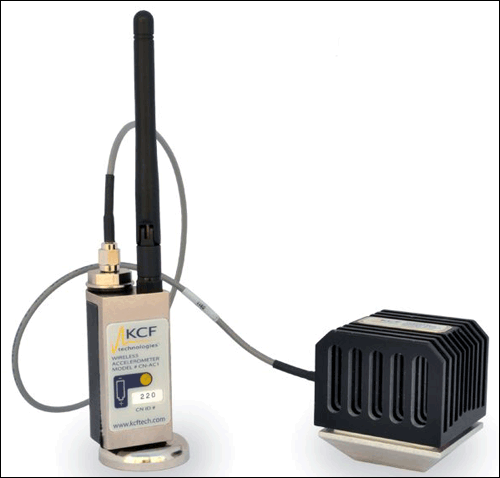KCF Technologies, a spin-off company created in 2000 by two Pennsylvania State University faculty members and a recently graduated PhD student, is commercializing energy-harvesting wireless sensors, after completing a decade of research and development. The complete system, known as Smart Diagnostics, consists of active RFID tags with built-in vibration and heat sensors, as well as RFID receivers and software to manage data culled from sensor readings. The solution is designed for rugged industrial and military applications, to help users monitor the conditions of machines at sites where it would be inconvenient or impossible to manually perform regular sensor readings.
At present, a paper factory, three power-generation companies and a university are testing a beta version of the technology. The university has attached the sensors to large heating, ventilation and air-conditioning (HVAC) units, while the other firms are monitoring the health of manufacturing or utility equipment. The U.S. Department of Defense (DOD) is employing several kits that include the KCF sensors, along with receivers and software for tracking the condition of helicopter blades. In addition, the company reports, the DOD is testing the technology on the U.S. Navy’s nuclear submarines, for a Small Business Innovation Research (SBIR) project, with tags placed on certain parts of each submarine. During all of the deployments, each user is monitoring its machinery’s condition based on the levels of vibration and heat—and any fluctuation of those levels—and that information is then transmitted to that firm’s back-end system via active RFID.
KCF Technologies offers a variety of technology solutions related to sensor data. One such product is the Smart Diagnostics system, developed with financial support from the U.S. Department of Energy, in support of the agency’s efforts to improve machine-health monitoring and thus increase energy efficiency, and with the DOD. According to David Shannon, KCF’s business development and marketing VP, the company was founded, in part, to enable “the Internet of Things for very hard problems.” The firm has been focusing on a system that would enable companies, such as manufacturers or utility companies, to track the condition of their equipment—located within remote areas, or places where human access may be limited—in real time, without requiring an individual to walk through his or her facility, manually performing sensor readings.
The health and efficiency of a piece of equipment—such as a compressor, chiller, generator or fan—can be gauged by its amount of temperature and vibration, Shannon explains. When a mechanical item begins to fail, he says, its vibration and temperature levels may rise very gradually—something that is difficult to detect unless sensor readings are taken on a regular basis. While companies that manufacture the equipment sometimes offer sensor technology, the sensors typically must be wired, which can be very expensive. KCF sought an easier, less costly solution for businesses that may not have the necessary budget to purchase and install the wired solution.
KCF’s developers tested existing off-the-shelf RFID hardware, and found that none provided the functionality required in rugged environments, or were capable of transmitting sensor data with minimal power. Therefore, the team developed its own active 2.4 GHz RFID sensor tags, using a proprietary air-interface protocol. “The challenge was pulling relatively high bandwidth info—temperature and vibration sensor data—in a very low-power way, over a radio network,” Shannon states.
The resulting sensor tags can be operated by either by a AA battery (which can last approximately eight years, if the tags transmit data once per hour), or by a choice of three forms of energy harvesters that utilize thermal, solar or vibration energy. A KCF tag, measuring about 1 inch by 1 inch by 2.45 inches, has built-in vibration and temperature sensors, and can be affixed directly to a machine either via screws, a magnetic mount or epoxy. The magnetic mount is preferable, Shannon notes, if the tag will be moved from one machine to another over time. The energy harvester plugs into the device, and would be attached separately. The vibration harvester draws energy from the machines’ vibrations. The temperature harvester draws power from heat—thus, the machine would need to be 10 to 15 degrees warmer than the ambient air. The solar harvester may be the more appropriate choice for a machine located outdoors and exposed to direct sunlight.
The tag can be preset to send information at specific intervals, from once a minute to once daily. It transmits its own unique ID number and sensor data to a receiver—another relatively small device, measuring 1.8 inches by 1 inch by 2.5 inches. The read range is typically 70 meters to 100 meters (230 feet to 328 feet), depending on the environment involved, as well as any obstructions. Typically, around 24 sensors tags can transmit to a single receiver. The receiver is connected via a USB cable to a laptop or PC, or to a “collection server box” on which KCF’s Smart Diagnostics software resides. The software, based on Microsoft‘s SQL, gathers data and makes it available to an end user in the form of a list of sensor readings for each machine. It can also display alerts to users logged onto the system, in the event that there is a change in readings over time.
By late January 2012, KCF Technologies expects to begin selling the solution commercially, as a kit designed to enable users to set up a small-scale system very quickly. The kit will cost less than $5,000, Shannon says, for three to 10 sensors (depending on an end user’s particular needs), a receiver and software. After using the kit, an end user could then determine whether it wanted a full-scale deployment.
A beta version of the kit is currently being tested by the university and companies, as well as by the Department of Defense on the submarines (the DOD is employing an earlier version of the technology, designed specifically for monitoring helicopter-blade vibrations). The customers are testing the kits with sensors on a limited number of machines, and then comparing the results against the amount of time required to obtain sensor reading manually, as well as the accuracy and quantity of data in the Smart Diagnostics application versus the manual method.



